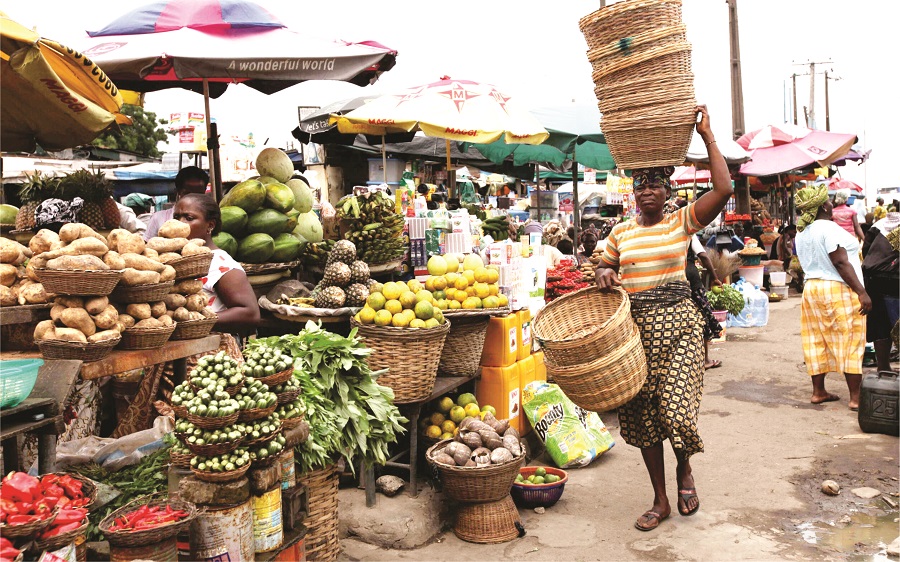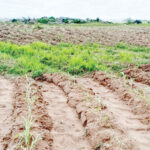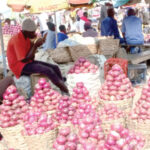The president’s national broadcast on July 31, 2023, embodies all the elements of the July 13 declaration of emergency on food security. They can, therefore, be taken together in emphasizing some quick steps that can kickstart the process of bringing down food prices in an emergency.
As a background, the importance of food is stressed by the fact that it accounts, on average, for about 56.65 percent of household expenditure (NBS 2009). The declaration of emergency on food security, if effectively implemented, can bring much relief, especially to poor households and prevent a possible breakdown of law and order that may come from potential food riots.
The purpose of this note is to draw attention to areas that need immediate action by the governments and other stakeholders in order to stem the rising food prices and the consequential hunger crisis in Nigeria.
- IYD 2023: Tinubu assures of 1m jobs in digital economy
- Kano govt revokes licences of all private schools
- Prioritise the reduction of Post Harvest Losses (PHLs) and Increased Farm Productivity over increased food production
Much emphasis appears to be placed on increased food production (irrigation of farmlands for all-year-round food production, activation of land banks, clearing 500,000 hectares of land for farming including clearing more forests) as a solution to inadequate food supply and bringing down food inflation. Quite contrary to this conventional view, Nigeria potentially produces enough food to feed the nation. The immediate constraint to Nigeria’s food self-sufficiency and food security is not, therefore, inadequate production, but the HIGH post-harvest losses experienced in the country. Smallholder farmers in Nigeria are responsible for over 80 per cent of the total production of agricultural commodities in the country. Crop production is about 90 per cent of Agric GDP, but an average of 40 per cent of the total produce goes to waste as a result of high post-harvest losses, arising from poor road infrastructure, inadequacy and lack of access to proper storage, handling and logistics challenges (see Nigeria Agenda, 2050). Specifically, Nigeria’s PHLs range from 30 to 40 per cent for roots and tubers, and between 40 and 60 per cent for perishables. To put this in perspective, Nigeria has one of the highest PHLs among its peers. For example, India suffers between 5 to 12 per cent PHL; South Africa, 10 to 20 per cent of grains and 52 per cent of fruits and vegetables. Similarly, Kenya suffers from 12 to 20 per cent for grains and 50 per cent for perishables.
In order to appreciate the magnitude of the PHLs crisis in Nigeria, for example, it is estimated that Nigeria produces 17 million tons of yams annually, cultivated over 2,837,000 hectares. 40 per cent PHL amounts to a loss of 6.8 million tons of yams and a corresponding 1,134,800 hectares of land wasted to cultivation nationally. Similarly, Nigeria produces an estimated 2.3 million tons of tomatoes annually, which are cultivated over 668,292 hectares. A conservative 45 per cent PHL amounts to 1.035 million tons of wasted tomatoes and wasted cultivated land of 300,731.4 hectares. These examples can be expanded to cover various other crops. The point here is that, of the estimated total land area of 30.7 million hectares already under cultivation in Nigeria, at a conservative PHLs of 30 per cent, translates to a minimum of 9.21 million hectares of land wasted to cultivation. Nationally, the total monetary value of post-harvest losses was estimated at N3.5 trillion in 2020, which was more than the food imports of N3.0 trillion and about 11 percent of crop GDP of N33.2 trillion in the same FY 2020.
Food Waste: From Five-Star Hotels, Eateries and Homes, the UN estimates that 37.9 million tons of cooked food are wasted in Nigeria annually, translating to feeding about 69 million Nigerians in a year at 1.5kg per day. According to the UN, Nigeria’s food (plate) waste is one of the highest in Africa. (NA 2050)
Yield per hectare: Nigeria has not fared better in yield/ha either. Comparative productivity numbers for maize are, Nigeria 1.7 tons/hectare, Egypt: 8.0 tons/hectare and South Africa: 5.3 per hectare,
Post-harvest losses, low productivity and food waste in Nigeria are major contributors to food inflation, food insecurity, and poverty. Bringing more land under cultivation for increased food production, without first reducing post-harvest losses and enhancing productivity, will mean higher food losses and more hectares of land wasted to cultivation. Food waste by the rich reduces the food available to the poor. Reduction in post-harvest losses and enhanced productivity should, therefore, be ranked relatively higher in the period of emergency than putting more land under cultivation for increased food production. The River Basins, in collaboration with the states, can revive the extension services to farmers. The National Productivity Centre can design a practical template for productivity improvements for all the key sectors, especially in agriculture and manufacturing. Enlightenment campaigns and discriminatory VAT imposed on food eaten in big hotels are possible strategies for reducing food waste.
What are some of the specific strategies for reducing post-harvest losses?
- a) Improve Nigeria’s storage facility:
Nigeria’s less than 5 per cent storage capacity for grains is the lowest among comparator countries. (RSA: 100%+, China: 100%+, Brazil: 28%). In other words, of the estimated 30 million tons of grains and oilseeds produced every year, the country’s warehouse storage capacity can only take in just 1.5 million metric tons. Why produce more only to waste more?
The federal government has many largely dormant aggregation/storage facilities dotted across the country that can be revived in collaboration with the commodity exchanges and other stakeholders. Our immediate strategy is to achieve effectiveness in the aggregation, handling, and storage of grains in particular, thereby reducing post-harvest losses to the barest minimum. Preparatory steps can be taken immediately for the year 2023 farming season that will set a benchmark for subsequent years’ harvests. In specific terms, there are, under the Ministry of Agriculture and its agencies, 33 silos with a combined capacity of 1,275,000 metric tons, 19 of which have been concessioned to the private sector; 48 community warehouses across the country for addressing the post-harvest losses at farm gate and community level. The Grain Aggregation Centres in particular, set up by Fadama III, can carry out primary post-harvest operations, such as cleaning, drying/moisture control, destoning, grading, weighing, and standardised bagging. In addition to the listed opportunities, farmers can take advantage of the electronic Warehouse Receipt System (eWRS) to sell produce even remotely, which will guarantee the quality and security of the produce to potential buyers.
- b) Do not establish a national commodity board
Nigeria’s private sector is in the lead in Africa in establishing commodity exchanges. A National Commodity Board is anachronistic. It will not promote price discovery and may frustrate private sector investment in Commodity Exchanges. A national commodity board will be another bureaucracy we can ill afford. It will serve better to incentivize the private sector to invest more in commodity exchanges that will, among other advantages, guarantee quality, and promote transparency and price discovery that will further enhance the efficiency of the market mechanism. Ethiopia and Ghana commodity exchanges are publicly owned but privately managed. Nigeria only needs to leverage the private sector commodity exchanges and spare itself the cost of bureaucracy and the fiscal burden of a national commodity board.
- c) Encourage states to invest in more storage facilities
Encourage the states to collaborate with the River Basin Development Authorities, Nigeria Stored Products and Research Institute, and the private sector, to build storage facilities, possibly down to the ward level, that are relevant to the farm produce and products in respective ecological zones.
- d) Construct rural roads and enhance farmer/farm security
Engage with the states and development partners to scale up the Rural Access and Agricultural Marketing Project (RAAMP) nationwide, to facilitate the movements of inputs to the farm and evacuation of produce to the markets and aggregation centres. As an emergency, the focus can be on the construction of culverts and mini bridges in rural areas. Security is now needed not only for the farmer to access the farmlands, but also to ensure the security of the farms through to harvest. Ensuring the security of farms is a complex challenge, requiring tapping into local initiatives.
- e) Remove roadblocks and reduce the power of commodity market associations
Free the highways to promote interstate trade. As already recognized by the government, one of the immediate frustrations to farmers and businesses in the food subsector is the blockage of highways, both formal and illegal, by produce inspectors and tax collectors. A ban on roadblocks and the enforcement of this ban is a matter of urgent priority in order to significantly reduce the time and lower the cost of moving food from the relatively surplus areas to the market and thus help to lower food prices. At the marketplaces, the control over food prices by the ‘Iya-loja’ and their equivalent in major markets across the country, will need intervention by the (state/local) governments in order to enhance access to the marketplace by farmers and food traders, who are not members of the associations and so promote more competition in the food market.
2 Medium to long-term issues
Preserve the forests and emphasise zonal/regional comparative advantage in farming. In the first Republic, a conscious policy advantage was taken to exploit the regional comparative advantage in farming. This policy strategy should be restored and promoted. The idea of clearing forests for seasonal farming should be discouraged totally. Forestry is an economic activity of its own with advantages that dwarf any farming activity that will be practised on the cleared land. The CBN’s cheap intervention fund, promoting forest clearing to plant maize and cassava on a commercial scale in the south is misleading many governments in the region to embark on a programme of deforestation. Nigeria cannot be borrowing money for the building of the Great Green Wall (GGW) in one part of the country to stem desertification and at the same time decimating its natural forests in another part of the country. Deliberate deforestation is inconsistent with the current existential challenges posed by climate change nationally and globally. The NA2050 promotes the desert-to-food programme (DTF) to slow down and reverse the desert encroachment in northern Nigeria and to serve as the economic backup to the GGW. It is strongly recommended that the Tinubu administration considers the implementation of the NA2050 in its five-year cycle. The first of the six cycles, NDP 2021-2025, is running.
As for more land clearing, it should be taken with far greater sensitivity to the challenges of environmental degradation, productivity and land waste in crop production. The Federal Ministry of Agriculture responsible for the implementation of the emergency on food security is advised to study progress reports on the implementation of the Economic Sustainability Plan (ESP) on the agric segment in order to understand what progress was made and the challenges with respect to land clearing.
Take it back to the drawing table and give the states a role
The bulk of what has been presented up to this point should ordinarily be the responsibility of the states and local governments in the federation. The whole idea of the government’s plan “to (i) immediately release fertilizers and grains to farmers and households to mitigate the effects of the subsidy removal (ii) fund the agricultural value chain through the Central Bank of Nigeria (iii) deploy concessionary capital/funding to the sector, especially towards fertilizer, processing, mechanization, seeds, chemicals, equipment, feed and labour,” sounds very much like the familiar routine of transactions and patronage driven policies. We now know the soil classification of Nigeria and the fertilizer types needed for each type of soil and for specific crops. A quantum release of fertilizers to an unknown number of farmers either by location or by what they produce is merely impressionistic. President Tinubu has vowed to fight vested interests and cannot, therefore, continue to feed the bottomless pot of corruption by wanting to give farm inputs to farmers whose numbers, characteristics and location we cannot verify. Rethinking layers of responsibility and charting a new course in line with such responsibilities, driven by evidence and relevant data, will be more helpful.
On irrigation facilities, hopefully, of small earth dams, across the country, the important point to emphasize here is that, unlike rainwater, irrigation water is not for free. Even after the dam has been constructed, its effective use and sustainability depend on management. Unlike rainwater, the use of the dam will need to be budgeted for yearly by the agency that will be responsible for supervising and providing the services from the dam to the farmers. It will be helpful, therefore, to obtain from the Federal Ministry of Water Resources, reports on the existing dam facilities across the country and understand their operational challenges before we build more dams.
Ojowu, a member of the defunct PEAC to former President Muhammadu Buhari, wrote from Abuja

 Join Daily Trust WhatsApp Community For Quick Access To News and Happenings Around You.
Join Daily Trust WhatsApp Community For Quick Access To News and Happenings Around You.


